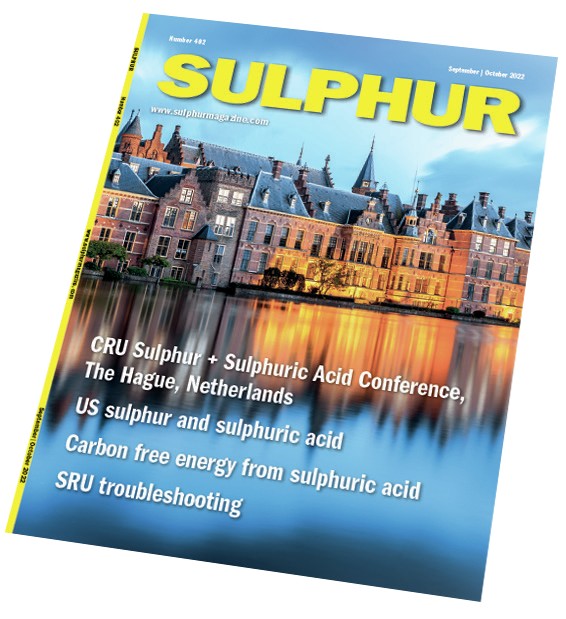Sulphur 402 Sept-Oct 2022

30 September 2022
Sulphur and renewables

The end of August saw a paper published in the Journal of the Royal Geographical Society by Dr Mark Maslin of University College London. Widely reported, it looked at the prospects for sulphur production in an era of declining fossil fuel use, concluding that there could be “a shortfall in the annual supply of sulphuric acid of between 100 and 320 million tonnes by 2040, depending on how quickly decarbonisation occurs”. It added that “unless action is taken to reduce the need for sulphuric acid, a massive increase in environmentally damaging mining will be required to fulfil this resource demand.”
“It may become worthwhile tapping highly sour gas reserves as much, if not more, for their sulphur content”
Now, these figures are surely designed to grab headlines, and we can consider them and some of the assumptions behind them in a moment, but the broad thrust of the paper is of course correct. However, I suspect that none of this will be news to long-term readers of Sulphur magazine or regular attendees at CRU’s Sulphur and Sulphuric Acid Conference. Papers by Dr Peter Clark, the former director of Alberta Sulphur Research Ltd, and consultant Angie Slavens of UniverSUL Consulting have been highlighting the potential shortfall in sulphur production caused by global decarbonisation since as long ago as 2012.
Now to those figures. They assume sulphur recovery from sour gas to be roughly constant out to 2040, with reductions in natural gas consumption in e.g. Europe as a reaction to the current Russian supply situation balancing increased use in e.g. China and India, while oil demand and hence production is based on a series of BP scenarios which range from a slight increase in oil use out to 2040 to an almost total phase-out on a pathway towards ‘net zero’ carbon emissions to 2050. Sulphuric acid demand is projected to increase to feed additional nickel, cobalt and neodymium demand for electric vehicle batteries and other green technologies. No account is taken of increased sulphuric acid production from metal smelting, although it mentions pyrite roasting as an alternative source of acid. Its main conclusion is that research is needed into cheap and environmentally friendly methods of extracting sulphur from sulphate materials such as gypsum and anhydrite, as the report correctly points out that the cost of extracting sulphur via Frasch mining is much higher than the generally prevailing price for extracting it from oil and gas over the past 50 years (and, as Peter Clark would doubtless point out, the number of sites around the world actually suitable for large scale Frasch mining are nowhere near enough to make up for the projected shortfall in sulphur production).
What the report does not consider, as Peter and Angie did in a joint presentation at the 2018 Sulphur Conference, is that if sulphur’s value increases due to scarcity, it may become worthwhile tapping highly sour gas reserves as much, if not more, for their sulphur content as their methane content. Likewise highly sour crudes such as oil sands bitumen could become favoured because of their sulphur premium. The report does however sensibly suggest that we can lower demand for sulphuric acid by more efficient use of phosphate fertilizers, and recycling of sewage and other wastes to produce phosphate-containing fractions. Other methods of extracting phosphates without the use of sulphuric acid are also available of course, such as the Improved Hard Process.
It is certainly true that we have become used to an era of sulphur surplus, and will need to make some mental adjustments over the next couple of decades as the global use of fossil fuels declines. But with due deference to Dr Maslin, I don’t think that we are likely to face a sulphuric acid supply shortfall of 100 million t/a in 2040, let alone 320 million t/a.






